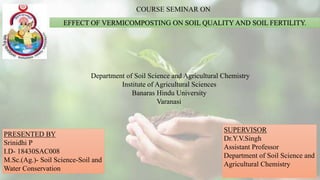The document discusses the effects of vermicomposting on soil quality and fertility. It begins with an introduction to vermicomposting and describes the methodology used. Key points include that vermicompost contains high levels of nutrients that improve soil structure and microbial activity. A case study showed that applying vermicompost to capsicum plants increased internode length compared to control plants. In conclusion, vermicompost enhances soil quality by increasing nutrients, aggregation, and beneficial microbes.






























